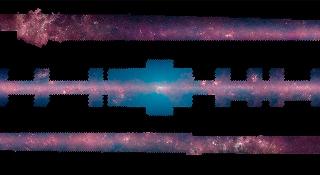
When you look up at the Milky Way on a clear, dark night, you'll see a band of bright stars arching overhead. This is the plane of our flat spiral galaxy, within which our solar system lies. Photo: NASA/JPL-Caltech/University of Wisconsin
WASHINGTON (PTI): Using more than 2 million images collected by NASA's Spitzer Space Telescope, scientists have developed a dramatic 360 degree portrait of the Milky Way, providing new details of our galaxy's structure and contents.
The new composite picture was developed by scientists from the University of Wisconsin-Madison, using infrared images gathered over the last decade.
In addition to providing new revelations about galactic structure, the telescope and the images processed by the Wisconsin team have made possible the addition of more than 200 million new objects to the catalogue of the Milky Way.
The galactic portrait, known as GLIMPSE360, provides an unprecedented look at the plane of our galaxy, using the infrared imagers aboard Spitzer to cut through the interstellar dust that obscures the view in visible light.
"For the first time, we can actually measure the large-scale structure of the galaxy using stars rather than gas," said Edward Churchwell, a University of Wisconsin-Madison professor of astronomy whose group compiled the new picture.
"We've established beyond the shadow of a doubt that our galaxy has a large bar structure that extends halfway out to the sun's orbit. We know more about where the Milky Way's spiral arms are," Churchwell said.
The new GLIMPSE composite image will be made widely available to astronomers and planetaria.
The data is also the basis for a "citizen science" project, known as the Milky Way Project, where anyone can help scour GLIMPSE images to help identify and map the objects that populate our galaxy.
Lofted into space in 2003, the Spitzer Space Telescope has far exceeded its planned two-and-a-half-year lifespan.
Although limited by the depletion of the liquid helium used to cool its cameras, the telescope remains in heliocentric orbit, gathering a trove of astrophysical data that promises to occupy a new generation of astronomers, researchers said.
 Previous Article
Previous Article Next Article
Next Article












The Indian Air Force, in its flight trials evaluation report submitted before the Defence Ministry l..
view articleAn insight into the Medium Multi-Role Combat Aircraft competition...
view articleSky enthusiasts can now spot the International Space Station (ISS) commanded by Indian-American astr..
view article